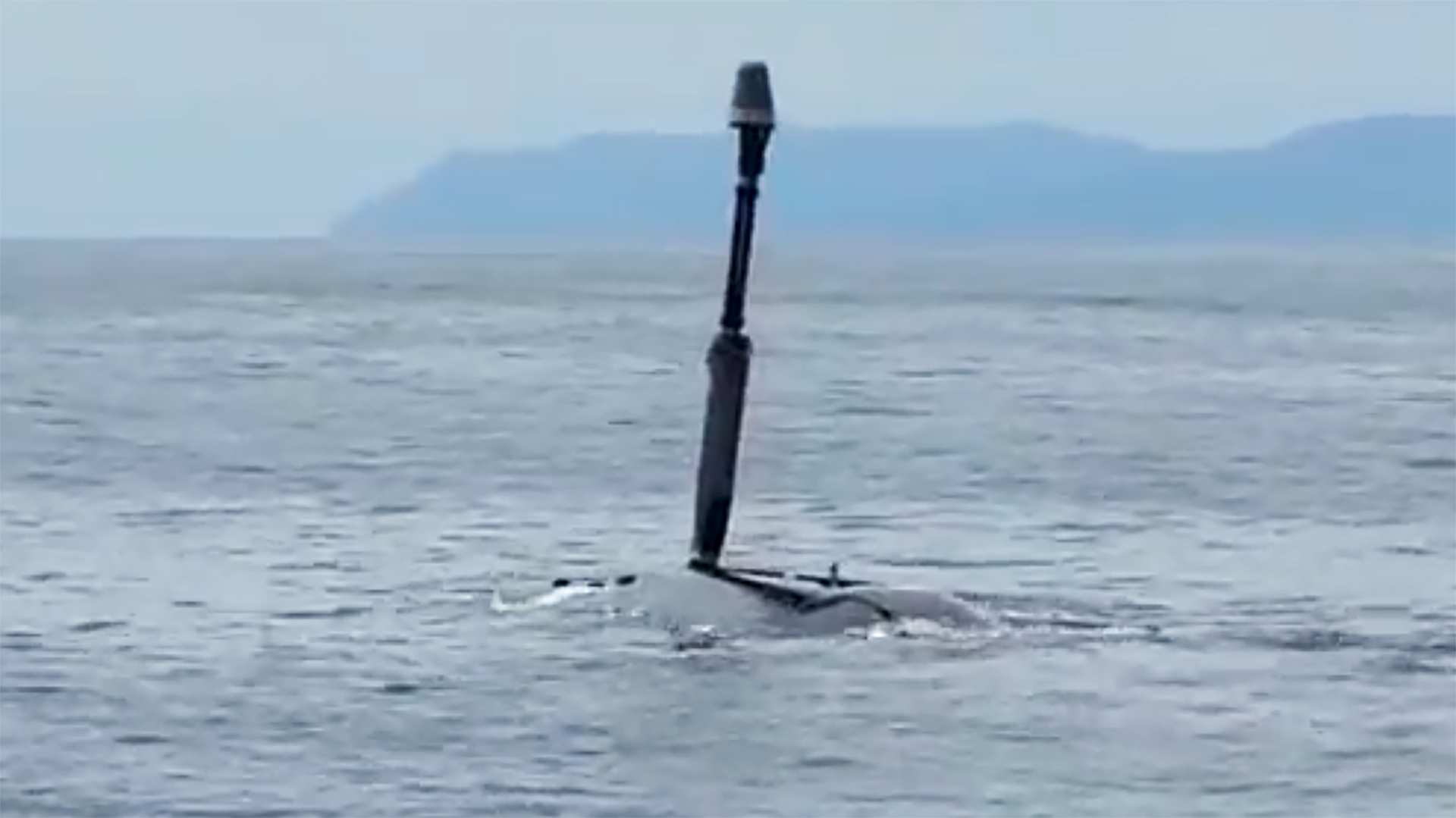Boeing Defense has released the first video of its Orca extra-large unmanned undersea vehicle, or XLUUV during at-sea testing. The Pentagon in 2019 ordered an initial batch of four of the 80-ton Orcas for the U.S. Navy, with a fifth added later that year. Since then, we saw the christening and launch of the test asset at Huntington Beach, California, in April last year, but we hadn’t previously seen the long-endurance craft underway in the water.
The 33-second video was presented on Twitter by Boeing, together with a caption noting that “full, advanced autonomy allows the vehicle to operate for months at a time in open, congested and contested waters with little-to-no human intervention.”
The Orca’s extendable mast is seen breaking the surface of the water, while the craft is ‘photo-bombed’ by a pod of inquisitive dolphins. The mast is designed to be raised when the Orca is at or close to the surface and serves a number of functions, including satellite connectivity.

The date and location of the video are not stated, but previously, it had been expected that at-sea testing of the Orca would start in the summer of 2022.
It has not all been plain sailing for the Orca program. Last September, the U.S. Government Accountability Office concluded that the program was at least $242 million or 64 percent over its original cost estimate and at least three years late. At one time, Boeing planned to deliver the first vehicle by December 2020 and all five by the end of 2022. Now, the final vehicle is slated for delivery by June 2024.
As initially configured, the Orca is to be outfitted to dispense undersea mines, with the anti-ship weapons stowed in a 34-foot modular payload compartment that has an eight-ton payload capacity.

While minelaying has been identified as the first mission for the deep-diving Orca to explore, the modular mid-section section of the XLUUV can accommodate different modular payloads, meaning it can be adapted to a variety of other tasks, too.
The Navy wants the Orca to also conduct underwater surveillance, electronic warfare, and minesweeping missions, and future payloads are expected to include a synthetic aperture sonar for ocean-floor mapping. Beyond that, there is also interest in adding different weapons, including cruise missiles and torpedoes, and even aerial drones, to XLUUVs like the Orca.
Other key features of the Orca include a hybrid diesel-electric propulsion system, allowing it to run submerged silently on battery power. The batteries are recharged using air-breathing diesel generators while running on or very near the surface (snorkeling). The combination of a diesel engine and modern lithium-ion batteries should allow the Orca to stay at sea for months while cruising at around three knots.
Also contributing to noise reduction is a shrouded propulsor, rather than a conventional propeller, which is also more efficient for the kind of operational profiles Orca is intended to execute.
What’s still less clear about the Orca is how the Navy will eventually deploy it, in terms of launch and recovery, and its broader concept of operations. Beyond that, establishing a concept of operations for XLUUVs, in general, is a key part of the Orca program. Understanding the benefits and limitations of its autonomy are key to this.

As for the at-sea trials, we don’t know for sure whether the Orca prototype is already being tested for minelaying operations, but there is no doubt that the Navy is enthusiastic in general about the vehicle’s potential for this mission.
In particular, the Navy is looking to see if the Orca — or another XLUUV of similar size — will be able to sow mines discreetly in difficult-to-reach areas that crewed submarines cannot access, including inside ports. If it can, the Orca and potential follow-on XLUUVs could start to be armed with some of the exotic new types of sea mines the Navy is now developing. You can read more about these here.
Crucially, while the Orca is notably big for an unmanned submarine, it’s still dwarfed by most crewed submarines and is obviously more expendable. Operating autonomously across vast expanses of the ocean, it offers significant advantages for missions such as blocking strategic maritime chokepoints and shutting down enemy ports, shipyards, and seagoing commerce. It could also potentially place mines in rivers, canals, and shallow coastal areas, deep within hostile territory.

Another factor that plays into the significance of Orca is the Navy’s decision to cancel Snakehead, a large UUV. Among other issues, this vehicle turned out to be unsuitable for deployment from a nuclear submarine’s dry dock shelter (DDS) as had been planned.
Without Snakehead, it’s very possible that the Navy will be even more reliant upon its small fleet of Orcas as it seeks to explore the potential for future, larger unmanned submarines.
And with Russia and China, among others, also working on XLUUV designs, the importance of the Orca, and the test data it will generate, becomes even more compelling.
Contact the author: thomas@thewarzone.com
